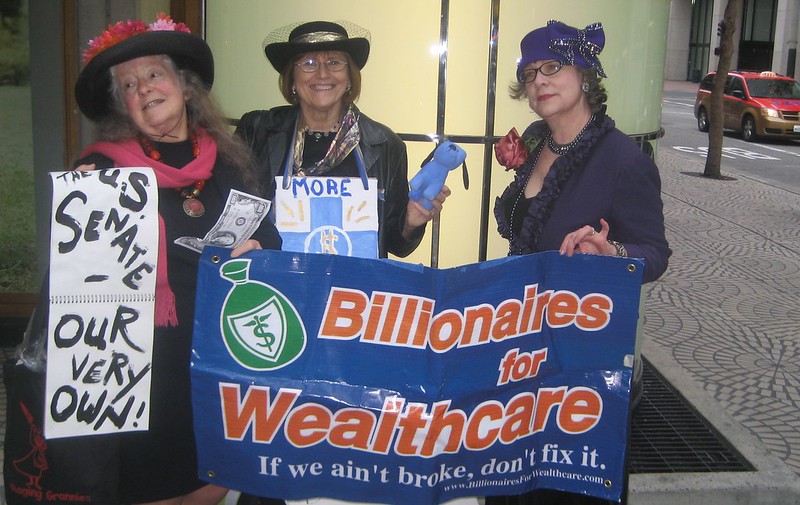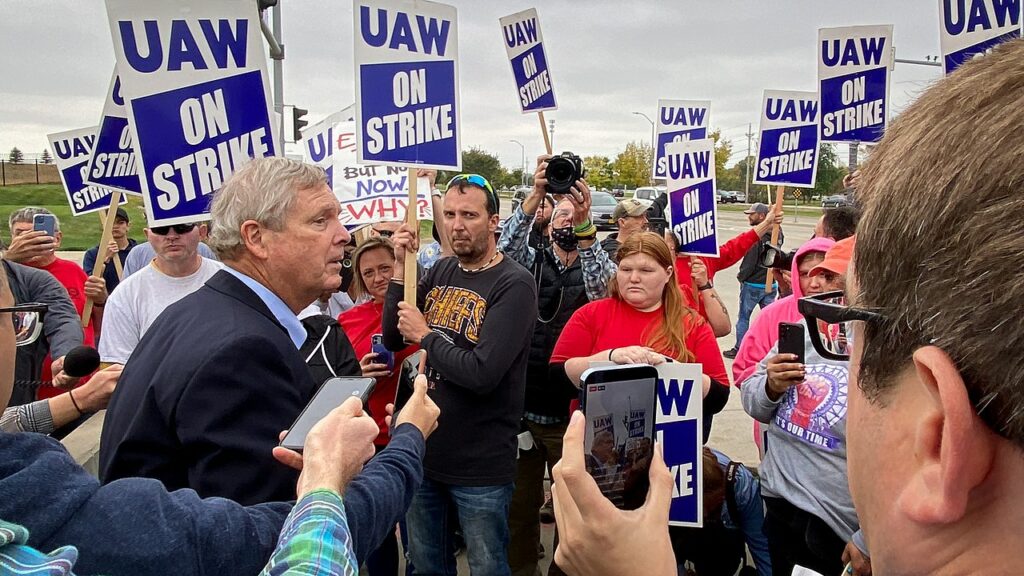Over the last couple of years, social democrats and liberals have turned into contortionists trying to explain why the U.S. Left is already on the winning path. More of the same has followed the November 2021 elections.
In an especially disappointing article, baldly titled, “Last Week’s Elections Were Not a Repudiation of the Left” Jacobin’s Branko Marcetic resorts to rhetorical tricks. In this imaginary New Jersey Governor Phil Murphy—25 years Goldman Sachs alum, and former finance chair to the Democratic National Committee, and Ambassador to Germany—gets painted as a “progressive” and a friend of the socialist Left. And the fact that 23 of 33 candidates endorsed by the Democratic Socialists of America (DSA) won election last week is held up as further evidence, without much thought to either the politics of these candidates, their endorsement, or their ultimate accountability to DSA and the Left.
In this context, Tempest welcomes the post-election analysis by Kim Moody, author of the forthcoming Breaking the Impasse: Electoral Politics, Mass Action & The New Socialist Movement in the United States from Haymarket Books.
The recent Democratic defeat in Virginia, near defeat in New Jersey, and losses elsewhere underline a problem about which social democratic and progressive Democrats in Congress seem unaware. They are right that coming out of the worst of the pandemic, working-class people want economic relief, better jobs, and genuine advances on income (as the “quit” rate and strike uptick indicate), healthcare, good schools, housing, and more. Yet Democratic Congressional self-styled progressives (from the Squad to much of the Congressional Progressive Caucus (CPC)) have abandoned any hope of their original goals such as the Green New Deal, Medicare-for-All, serious taxes on the rich, etc. Rather, they have settled on the Biden agenda (the Build Back Better budget bill) as the “left-wing of the possible” in terms of legislation.
In so doing, this Democratic Party left has engaged with more determination than most of their fellow Democrats who are actually more favorable to the Biden agenda. They have signed up to save the Democrats from themselves. Faced with stubborn resistance from the party’s right to a big “tax and spend” budget (the reconciliation bill), the Congressional left has borrowed the minority obstructionist tactics of the Manchin-Sinema-Blue Dog right. In this case, the progressives refused to pass the infrastructure bill they know the right desperately wants for its “pork” benefits until the budget reconciliation bill—that contains such social benefits as there are in the Biden agenda—is passed. Chair of the CPC Pramila Jayapal has stood firm, although she has brought only about half of the CPC’s 95 members with her in this tactic. Nonetheless, as parliamentary maneuvers go, this no doubt seemed pretty shrewd.
The problem is: what works for the right doesn’t necessarily work for the left—not for the liberal-progressive legislative left and its tiny socialist minority. The miscalculation in this tactic is that the right knows they will eventually get the infrastructure bill because the progressives and the Biden Administration, not to mention important sections of capital, need it as well. The Manchin-Sinema-Blue Dog Senate-House mafia could wait a while for this year’s pulled pork. They demanded more and more concessions, certain in the knowledge that the Biden administration cannot afford a government shut-down later this year given its already plunging approval ratings and need to hold onto its slim majority in 2022. And, of course, that is what happened.

Thus, the real leverage here was always with the right. So, they held out consistently and forced the centrist Democrats to whittle down the budget and its social benefits. The social-democratic left has put itself in the position of being the staunchest defenders of the Biden (wholly inadequate) “framework” and program even as its melts away before their eyes because Biden, the Pelosi leadership (which was supported by this same left) with approval of the centrists of the New Democrat Coalition and the moderates in the CPC cave in one step at a time. So, the budget has gone from Senate Budget Committee Chair Bernie Sanders’ original $6 trillion to $3.5 trillion, and now down to $1.7 trillion.
Since all of this drawn-out maneuvering and its general ineffectiveness in moving the right has been well-publicized in the media, what the voting public sees in the Democratic Congress and the Biden administration is not the relief they crave or at least hoped for, but endless, increasingly bitter squabbles between members of the governing Democratic Party. While the Republicans oppose all the even remotely progressive aspects of the reconciliation bill, they have had the luxury of sitting, hands folded and watching the Democratic center and right do their work for them—with, of course, the occasional vicious racist attack, such as that on Rashida Tlaib for opposing the Iron Dome missile gift to Israel. (Some Democrats joined the attack, while not one Democrat stood to defend her. An almost insignificant eight Democrats voted against Iron Dome, and two—AOC and Henry Johnson of Georgia—vainly sought political safety in voting “present.” While nominal DSA member, Jamaal Bowman, voted in favor.)
The Democratic Party’s Congressional left‘s tactic, its right’s intransigence, and its center’s predictable spinelessness is to political quagmire what Vietnam and Afghanistan were to military quagmires—though, of course, even with COVID-19 deaths and the deprivation that will result from legislative retreat the human cost of those two “endless wars” was far greater. Nevertheless, the consequence of this Congressional quagmire is a contribution not only to the recently lost elections in which young (disillusioned?) Democratic voters failed to turn out, Biden’s approval rating dove “underwater” (51.6 percent disapprove to 42.5 percent approve, as of November 11), and the almost certain loss of a Congressional majority in 2022. Not surprisingly, people who have emerged from a deadly, disorienting health and economic crisis that turned millions of lives upside down are not impressed by Byzantine maneuvers, parliamentary squabbles, and disappearing political promises.
Finally, Biden intervened and most of the Democrats voted in favor of the infrastructure bill with a promise from the party’s right not to gut the reconciliation bill much more than they already have. The vote was a nice measure of the relative backbone of the progressive wing of the Congressional party. The six Democrats who voted No were the Squad plus Cori Bush and Jamaal Bowman. All the other members of the Progressive Caucus voted yes along with the New Democrats, Blue Dogs, and 13 Republicans. But then the ending of this asymmetric battle was always going to look something like this.
The quagmire, however, is not limited to the current reconciliation budget bill or to Congress. It will arise again with any costly legislation that threatens increased taxation on the incomes or property values of higher income groups and which promises even marginal economic redistribution. This is because, on the one hand, the huge apparatus of the party at national and state levels now depends on funding from the wealthy and certain sections of capital and, on the other hand, the contradictory, cross-class electoral coalition that is the current basis of a Democratic majority in Congress and in the few state legislatures where there is one poses limits on reform. While its cross-class contradictory nature is not in itself new, the composition of this coalition is.
As has been shown again and again, over the last several election cycles the Democratic Party’s social and financial base depends more and more on upper income, property-owning (including shares and bonds), highly educated professionals, private equity and high tech entrepreneurs, and less and less on working-class voters of all races—the latter concentrated in a finite number of urban election districts that limit their leverage within the coalition.This is largely because much of the U.S. working class is now spread more or less thinly across what is mistakenly called “Rural America” where a multitude of plants, warehouses, truck barns, rail terminals, and other production- and transportation-related facilities are located from the Midwest and Upper South to the Great Plains where Democrats fear to tread.
Thus, at its electoral margins in the higher turnout suburbs and relatively better-off or even wealthy urban neighborhoods, the Democratic Party has an unstable coalition which is why the leadership almost always makes concessions in appointments and legislation to these well-to-do groups. While in extreme situations it requires only a handful of conservative and moderate Democrats to block and water down progressive legislation, more generally the large proportion of centrist office-holders in this contradictory coalition limits the scope of legislation in the first place. Today’s “left-wing of the possible” isn’t very left-wing.
It is into this broader quagmire that the DSA has clearly directed its electoral activities as of the 2021 convention. Gone is the “dirty break” in all but name, the Bernie bounce, the rhetorical bow to independent political action, and the growth of DSA itself—though perhaps 90 percent of that, it is now admitted, was paper growth. As the pundits like to say about the Democrats, we can say about the democratic socialists and DSA: this is a turning point. The failure to turn will be represented by the enormous temptation to throw huge organizational resources into the 2022 mid-term elections to save the Democrats from themselves—again. Even assuming that this would make a difference, it would at best simply salvage the status quo. At worst it would squander and demoralize the still slender human and political resources of democratic socialism in the U.S.
The alternative for this moment lies in the actual existing activity of the working class: the uptick in struggle and strikes aimed at halting the deteriorating economic and working conditions suffered now for a generation or more. The dynamism of this still fragile upsurge that began in 2018 with the rebellion of education workers comes from the workers and their families themselves which is why it is important. More important than sending socialist cannon fodder into marginal congressional districts. If this mini-strike wave continues and wins significant gains, it will do more to encourage unorganized workers to seek and build unions than the best designed top-down organizing drive with its cohort of hand-picked “organic leaders” and choreographed tactics. The first wave of real natural leaders is already emerging in the strikes and strike votes, contract rejections, and unofficial job actions in non-union places. They appear to have the backing not only of their fellow workers, but of the public which has registered the highest support for unions since 1965 at 68 percent. Congressional approval ratings, of course, have been low for years, but even among Democratic voters approval of today’s Democratic Congress fell from 55 percent in September to 33 percent by the end of October according to Gallup polls.

Like upsurges in earlier times, this has the potential to break the political impasse by the disruptive power it puts behind its demands for an end to the gross inequality and high profile obscene wealth of the few. It comes, like previous worker rebellions, at a time of rising social movements of all the oppressed, the by-passed, and the simply angry—all of which add to the potential for a politics from below. It has a better chance of beating back Trumpism at its roots through the experience of solidarity in action than all the maneuvers of Democratic office-holders. It is, of course, a gamble, a bet on an upsurge that might peter out. But it is where socialists need to be.
Featured Image Credit: Tempest.

